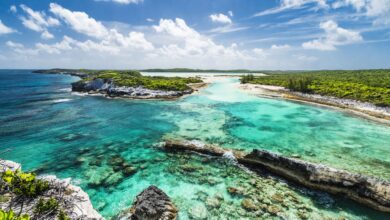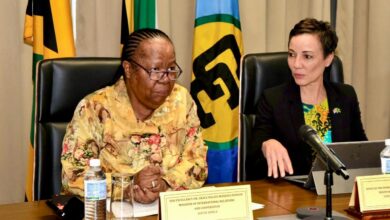Nearly 90 percent of Guyana’s population lives on a narrow coastline strip a half to one metre below sea level. That coastal belt is protected by seawall barriers that have existed since the Dutch occupation of the country. In recent times, however, severe storms have toppled these defences, resulting in significant flooding, a danger scientists predict may become more frequent.
The government is now spending six million dollars annually on drainage and irrigation and requires some 100 million dollars to adapt its drainage infrastructure to deal with the effects of climate change.
“Most of the inland territory, maybe 50 kilometres from here, is higher and the sort of doomsday scenarios that we might have to abandon some parts of the coastline, that would be a tremendous cost,” Granger says.
“That would be something that we don’t want to contemplate but you can never tell when a catastrophe could strike.”
An interview with Guyanese President David Granger from IPS News on Vimeo.
GEORGETOWN, Jun 10 2015 (IPS) – Despite its highly variable climate, Guyana is the only Caribbean Community (CARICOM) country that enjoys food security. But rapid climate change could pose a challenge not only for Guyana, but for its Caribbean neigbours who depend on the South American country for much of their produce.
Agriculture in Guyana accounts for 32 percent of Gross Domestic Product (GDP); 37 percent of all export earnings; and employs about one third of the labour force. Main agricultural exports are sugar, earning some 137 million dollars annually; rice, earning 55 million dollars, forestry, earning 70 million; fish products, earning 65 million; and other crops and livestock 7.5 million.
David Granger, who became Guyana’s new president after winning general and regional elections here on May 11, said his administration is not taking this for granted, and he is fully aware that climate change could cause the country to lose its food-secure status.
“On the coastland which is low and flat, the climate is actually slightly different to the hinterland and the forested mountainous areas where the rainfall is very heavy, part of the Amazonian rainforest; and deeper south, closer to Brazil you have a completely different terrain, a landscape of savannahs,” Granger told IPS.
“On the savannahs you have a long wet season, which is now taking place, and a long dry season. On the coastland we have a long dry season and a long wet season and a short dry season and a short wet season. So when we speak of climate change we’re speaking of very complex geographical phenomenon.”
Approximately 90 percent of Guyana’s population lives on a narrow coastline strip a half to one metre below sea level. That coastal belt is protected by seawall barriers that have existed since the Dutch occupation of the country. In recent times, however, severe storms have toppled these defences, resulting in significant flooding, a danger scientists predict may become more frequent.
The government is spending six million dollars annually on drainage and irrigation and requires some 100 million dollars to adapt its drainage infrastructure to deal with the effects of climate change.
“We have to plan a policy…we have to chart a course that protects our citizens and traditionally as far as coastal zone management is concerned. We have had to build sea defences and build proper drainage and irrigation works otherwise our people will be flooded out,” Granger said.
He related that the country experienced “a terrible flood exactly 10 years ago” and many of the communities on the coast were affected.
“We lost billions of dollars because of floods. So we have to protect our people from that type of catastrophe and we just have to continue what we’ve been doing traditionally in terms of seawalls but also we have to implement plans to prevent the excessive cutting down of our trees and of course reforestation to plant back areas that have been mined out.”
An impressive 80 percent of Guyana’s surface area is covered by rainforest the size of England. Beneath the jungle and savannah lie gold, diamond and bauxite – staples of Guyana’s economy.
Norway has committed to providing Guyana up to 250 million dollars by 2015 for avoided deforestation once certain performance indicators are met. Earnings from the partnership to date amount to 190 million dollars.
It is one of the highest payments worldwide for results achieved under a bilateral REDD+ partnership, second only to Brazil.
The partnership between Guyana and Norway began in 2009 and payments made to Guyana under it support the country’s ambitious climate action, keeping deforestation low while promoting development and sustainable economic growth through the country’s Low Carbon Development Strategy (LCDS).







